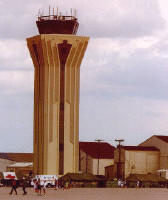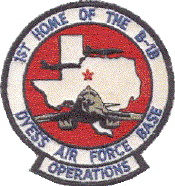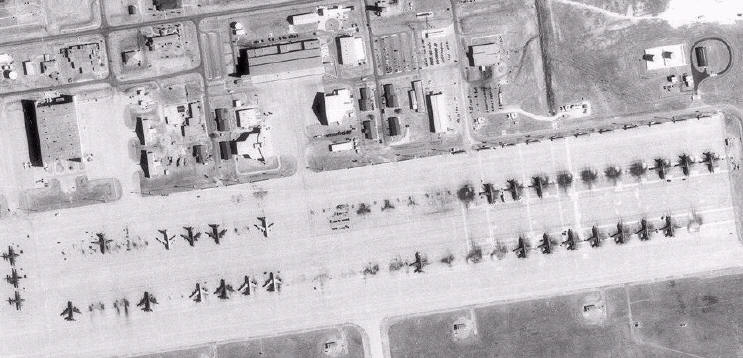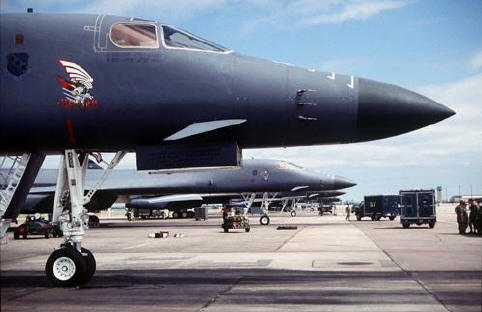| SAC Bases:
Abilene / Dyess
Air Force Base |
|
 |
Dyess AFB,
located a few miles south of Abilene, Texas, is home to the 7th Bomb
Wing, which consists of four groups. Two squadrons, the 9th and 28th Bomb
Squadrons, fly the B-1B. In addition, the 28th Bomb Squadron is the Air
Force schoolhouse for all B-1B aircrew members.
The base is
located in the southwest corner of Abilene, TX and is about 200 miles
west of Dallas. The base employs more than 5,000 people, making it the
single largest employer in the area.
The base is named after Lt. Col.
William Edwin Dyess, a native of Albany, Texas. Dyess AFB has nearly 200
facilities on base, plus 988 units of family housing, and encompasses
6,117 acres of land. The base has a total economic impact of nearly $310
million yearly on the local community.
The base has an Air Park with many famous warplanes on
display. |
 |
| History |
|
Dyess began as two
distinctly different military posts. Camp Barkeley was one of the many
"tent camps" hastily erected throughout the United States. It was used to
train Army infantry recruits. Adjacent to it was Tye Army Field, which
trained Army Air Corps cadets learned to fly trainers and P-47 Thunderbolt fighters.
Both
installations were closed at the end of WW II, and the army sold Tye Army Air Field to
the city of Abilene for $1. Fifteen hundred acres of it
were used by the Texas National Guard as a training facility.
Following the outbreak of the Korean crisis,
civic leaders besieged Washington, DC and Pentagon officials with their request
for a military installation. Armed with 1,500 acres and determination,
they
raised $893,000 to purchase an additional 3,500 acres to provide a home for the
military base they hoped would be in Abilene. The local community was interested
in providing for the Air Force an exemplary relationship between the community
and an Air Force base. |
|
SAC Base |
After
initial ground-breaking ceremonies on Sept. 24, 1953, construction of
the base progressed rapidly. Known as Abilene Air Force Base, the
Strategic Air Command base was dedicated by the city fathers at the end
of Abilene's Diamond Jubilee April 15, 1956. On Dec. 6 that same year,
the base was renamed Dyess AFB in honor of Lt. Col.
William Edwin Dyess.
The 341st Bombardment Wing, Medium was activated on
September 1, 1955 at Abilene (later, Dyess) AFB, Texas. It's B-47s were
being phased out so the wing was ordered to phase down for inactivation,
which occurred on June 25, 1961. It was redesignated the 341st
Strategic Missile Wing and activated ICBM
at Malmstrom AFB, Montana on
July 15, 1961. The 341st became the USAF's first Minuteman ICBM Wing .
The 96th Bomb Wing
was transferred to Dyess AFB, Texas on September 8, 1957. It
flew B-47E and KC-97s. The wing gained Atlas F missiles in July,
1961, manned by the 578th Strategic Missile Squadron. The first of
the Atlas went on alert in April, 1961. The unit was redesignated the 96th Strategic
Aerospace Wing on April 1, 1962. The Atlas was phased out in March 1965.
In 1963, it's three squadrons of B-47s were replaced
by one squadron of B-52s. The 96th received B-52Cs from the 99th
Bomb Wing, then new B-52Ds and B-52Es from Boeing. |
|
 |
|
B-52 on display at Dyess
Air Park |
On Feb. 8, 1961, Dyess Air Force
Base became home to the Tactical Air Command's 64th Troop Carrier Wing
(Medium) flying the C-130 Hercules Abilene and the entire Big Country
community celebrated President Reagan's announcement on Dec. 21, 1983,
that Dyess AFB would receive the Air Force's first operational B-1B's. The
arrival ceremony June 29,1985, for the Star of Abilene included more than
50,000 people, most from our host neighbor Abilene, Texas.
On Oct. 1, 1993, the 7th
Wing moved to Dyess AFB, Texas, flying both the B-1B Lancer and the C-130
Hercules. This unique structure of bombing and airlift under one wing
remained intact until April 1, 1997, when the Air Force transferred all
C-130s to Air Mobility Command. That same day, the 317th Airlift Group
stood up at Dyess, encompassing all Dyess C-130 assets and the 7th Wing
became the 7th Bomb Wing. Dyess has the only B-1B schoolhouse in the Air
Force, in addition to operational missions. |
| Recent History
|
|
1998 was truly a year of firsts for the 45-year-old base. The B-1B Lancer's participation in the Operation Desert Thunder exercise in
November was the first ever for the Dyess bomber. Then, barely a month later
during Operation Desert Fox, the B-1 debuted in combat. Operation Desert Fox was the four-day bombing of Iraq by American-led
military forces in December. "A defining moment for 1998 was preparing the B-1 for conventional warfare,"
said Dyess Commander Brig. Gen. Mike McMahan. "It was proven that the training
paid off for the crews, support personnel and maintenance." Originally a nuclear warplane, the B-1 is now outfitted with conventional
weapons. The bomber flew in support of 10 global power sorties in 1998. The plane's speed and long-range capabilities, combined with carrying
capacity (it can hold almost twice the number of conventional bombs as the B-52)
have made it the aircraft to watch. |
|
 |
|
Dyess also was recently recognized as one of the air bases that meets
preliminary criteria for housing an anti-missile system. The Airborne Laser is a Boeing 747 equipped with a laser beam in the nose.
When flying above cloud cover, the aircraft's beam could destroy
intermediate-range or cruise missiles in the boost phase of flight. The warhead
is not destroyed in the process, only the booster that propels the missile. Destruction so early in flight would cause the warhead to fall back on the
country that launched it, Hans Mark, chief technical adviser to the secretary of
defense told the Austin American-Statesman. Bringing the system to Dyess would add a coveted futuristic third mission to
complement the B-1 Bomber and the C-130 airlift mission. Such a move would help
secure Dyess from base closure lists, said Chairman of the Chamber of Commerce
Military Affairs Committee Frank Puckett. "The Military Affairs Committee made ABL its top priority a year ago and this
news was seen as the fruits of the committee's labor," Puckett said. "If ABL
does become the next additional mission for Dyess, it will be the biggest change
in the base since the B-1 Bomber arrived in 1985." The new mission could mean 500 to 1,000 new active duty personnel, $100
million in construction, seven or eight new 747 aircraft and a large group of
scientists, engineers and contractors who would work on the project. Sens. Kay Bailey Hutchison and Phil Gramm, and U.S. Rep. Charles Stenholm are
staunch supporters of bringing the anti-missile system here.
Today, nearly half of the nation's 93-plane B-1 fleet is assigned to the
base, where all B-1 pilots are trained. Dyess' mission also includes operations
and training for the C-130.
In March 1999, the 7th Bomb Wing at Dyess was named a lead wing of an
Aerospace Expeditionary Force. Being part of the expeditionary force will bring an additional 71 positions
to the B-1 unit and seven to the 317th Airlift Group.The Aerospace Expeditionary Force is made up of a predetermined set of
forces; aircraft, personnel and equipment, from which tailored force packages
can be rapidly deployed. Each AEF will operate a cross-section of Air Force
weapon systems consisting of 10,000-15,000 people and more than 150 aircraft
from a variety of separate active duty, reserve and National Guard units. As a
lead wing, Dyess commanders will provide leadership of those assets at the
tactical level.
Dyess heads into the new millennium as the city's largest single employer
with some 5,000 personnel manning 24 squadrons. The base population tops 11,000
when dependents are factored in.
|
 |
Third B-1 Squadron
The 13th Bomb Squadron will develop in two years as a training squadron
with 282 people and funding to fly two aircraft. By 2004, the third B-1 squadron
will become combat-ready with six planes funded and 432 military positions. Upwards of $15 million in on-base construction will precede the start-up. Scheduled for completion in 1999, a new engine repair center will allow Dyess
to repair and maintain a large percentage of the Air Force's B-1 Bomber
engines.
By the end of 1999, Dyess will have a new look about it, with the completion
of several construction projects. They include: a Marine Corps Reserve Center,
an Engine Regional Repair Center, additional 13th Bomb Squadron facilities,
Munitions and AGE facilities, and housing privatization.
Left: B-1Bs at Dyess |
|
